Introduction – What is a Waterspout Tornado?
Nature is a constant source of wonder and, often times, terror when it comes to its most powerful displays. Waterspout tornadoes; which are seen as aquatic versions of the more common and familiar land tornadoes present an opportunity to gawk at nature’s power in awe.
While they may look similar to their terrestrial counterparts, these spinning columns of air and water form above bodies of water and have their own distinct characteristics and formations. The science behind these twisters has plagued researchers for centuries but the knowledge we’ve gained over time has allowed us to better understand how they behave.
Florida Keys is known for having stunning scenes across its landscape but it’s also a hotspot for waterspouts. This area sees more waterspout activity than any other region in the United States making this area important for both researchers looking to learn about them as well as enthusiasts who simply enjoy watching in person.
Waterspouts can go from being gentle giants that barely touch the water’s surface all the way up to being powerful twisters that can cause serious damage to vessels, coastal areas, and marine life. Predicting them isn’t easy due to how varied they can be but understanding what conditions lead them to happen is key.
Being such beautiful events there’s no surprise that people want photos of waterspouts. These natural phenomena are the subject of photographers, tourists, and nature lovers because their beauty is hard not to appreciate despite their potential dangers. With so many examples throughout history it seems like people will never grow tired of marveling at nature’s whimsical side.
While onlookers might find them fascinating or mystifying or mesmerizing; sometimes even all three at once; National Weather Services tend not to share this sentiment when waterspouts form close enough onshore. They could clog up maritime routes or destroy structures on land if they were ever to get that far. Luckily we’ve gotten good at forecasting and responding to them in modern times thanks to advancements in technology.
The Essence and Evolution of Waterspout Tornadoes
Waterspout tornadoes, It’s human nature to be terrified of the unknown so one can only imagine how our ancestors reacted when they first saw a tornado over water. The folklore that’s followed these twisters over time isn’t just false, it’s counterproductive as well because misconceptions have led people astray from what should really be done in case they do happen again. By providing communities with factual information about waterspouts it’ll become easier for them to understand the risks and coexist with them as they move onshore.
Learning is an ongoing process which is why we can never say we’ve learned everything. As we continue to study waterspout tornadoes we’ll gain insights into their nature and evolution while also understanding more about Earth’s complex inner workings.
In the past, waterspouts were wrapped up in a lot of perplexing elements like myths and folklore. There was always some sort of supernatural explanation for them. But, thanks to scientific developments we now know what they really are: natural weather events. This shift from something unexplained to being part of meteorology shows how much our understanding about the world has grown.
Waterspouts can be separated into two categories: tornadic and non-tornadic. And this alone illustrates how diverse these water phenomena can get. Both types of formations follow their own distinct process and have different consequences on the environment and human activities. To accurately predict when they’ll happen and reduce their potential impacts, it’s crucial to have this intricate understanding about them.
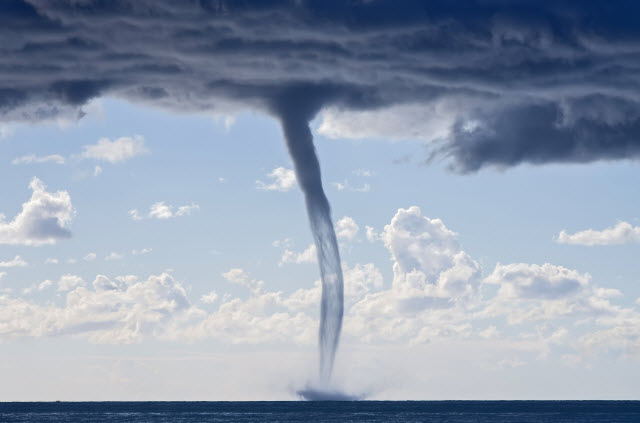
Decoding Formation: The Birth of a Waterspout
A waterspout is unlike any other weather condition, blending characteristics of a type of waterspout and, in rare instances, a tornado over water. It forms in the aftermath of another natural phenomenon, a severe thunderstorm. By connecting to powerful storm systems, these twisted water tornadoes appear out of nowhere and are absolutely captivating.
Meanwhile, fair-weather waterspouts form under calm conditions and are less intense than its counterpart. These fascinating spirals start on the surface of a body of water before slowly creeping up into the atmosphere. For several minutes to over an hour, they’ll provide quite the show. Unlike severe ones that crave a thunderstorm’s embrace, fair-weather waterspouts can form with simple localized updrafts that grab moisture from warm water surfaces and condense them into these interesting twisters.
The process of forming one includes multiple stages, notably when waterspouts develop on the surface of the water. First there’s dark spots appearing on the water surface which indicates moisture collection. Then comes the funnel that materializes through visible condensed water droplets. This big and strong tube stretches all the way from the bottom of whatever body it formed on to its cloud base above.
Climatology: When and Where Waterspouts Tend to Arise
Waterspouts don’t appear randomly. They form in specific weather and location conditions. Areas prone to severe storms, like coastal regions and islands, often see tornadic waterspouts. These waterspouts occur during intense weather events, like when NOAA issues a tornado warning. They form due to the link between severe thunderstorms and waterspout creation, often resulting in a tornado over water.
On the other hand, fair-weather waterspouts need warm, calm, and humid conditions. They usually appear in tropical and subtropical areas. The Florida Keys is an ideal spot for these waterspouts. The warm surrounding seas and sunny weather create perfect conditions. This region experiences both waterspout types, making it important for studying their climatology.
Waterspouts also have seasonal patterns. Fair-weather waterspouts happen more often in late summer and early fall when water is warmest. Tornadic waterspouts can occur anytime if storm conditions are right. This seasonal variability affects how often and how intense waterspouts form. For example, fair-weather waterspouts mainly occur in the Lower Florida Keys.
Learning when and where waterspouts tend to arise helps us understand them better. It also helps us predict and prepare for their impacts. Meteorologists monitor conditions that create waterspouts. This allows them to give timely warnings. Warnings help minimize risks from these mesmerizing yet potentially dangerous natural events.
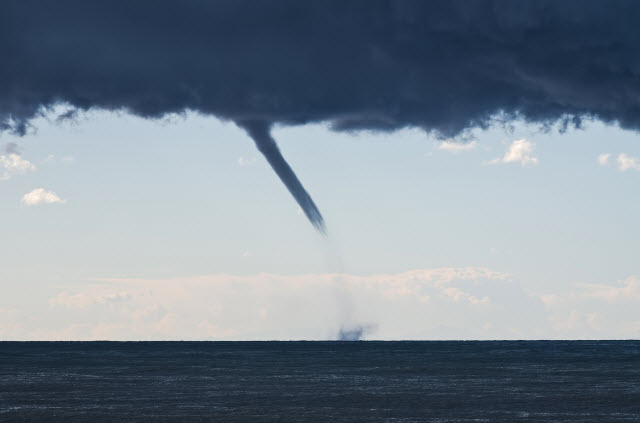
A Closer Look at Different Waterspout Tornado Types
Waterspouts are fascinating tornados that occur over water. There are various kinds, each with its own traits and ways of forming. These water twisters amaze people and scientists. Knowing the different waterspout types helps us grasp their impacts and predict when they might happen.
The Florida Keys is a prime spot for seeing many waterspouts. The area’s location and climate create ideal conditions for both waterspout types, making it a natural place to study them. The warm waters around the Florida Keys help fair-weather waterspouts form often, so they’re commonly seen there.
Tornadic waterspouts are like land tornados that form during storms. They can be very powerful. These twisters start rotating in storm clouds, then extend down to the water. Their formation links to supercell thunderstorms which can bring severe weather.
Non-tornadic or fair-weather waterspouts usually form in calm conditions without storms. They develop upward from the water’s surface, starting as a spinning flat base that picks up water. Unlike tornadic waterspouts, they aren’t connected to thunderstorms and are generally less dangerous.
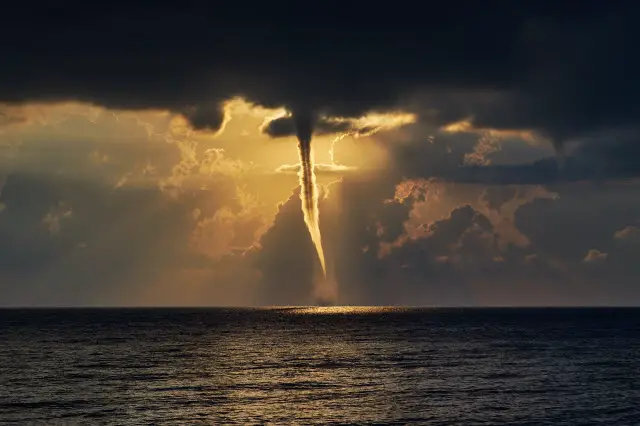
The Differences Between Tornadic and Non-Tornadic Waterspouts
Waterspouts come in two main types – tornadic and non-tornadic. Their formation process, weather conditions, and impact are different. Tornadic waterspouts start from the cloud and move down. They form in strong thunderstorms. These waterspouts are actually tornadoes that happen over water. They have very fast winds and can cause severe damage.
Non-tornadic waterspouts, also called fair-weather waterspouts, are quite different. They are more common but less intense. Fair-weather waterspouts form from the water’s surface and move up. They develop in calm weather conditions. Their formation process is less turbulent. These waterspouts don’t last long and usually disappear when reaching land. So, they rarely cause much damage.
To understand the differences, you need to look at their lifecycle and impact. Tornadic waterspouts can turn into tornadoes if they move over land. They stay intense and can threaten buildings and lives. But fair-weather waterspouts tend to be weaker. Since they usually stay over open water, they rarely cause harm.
Knowing what type of waterspout it is, is important for safety. People on ships or living near coasts need to know about weather conditions. This helps them prepare for either type of waterspout. Being aware and ready can reduce risks from these natural events. It keeps people in vulnerable areas safe.
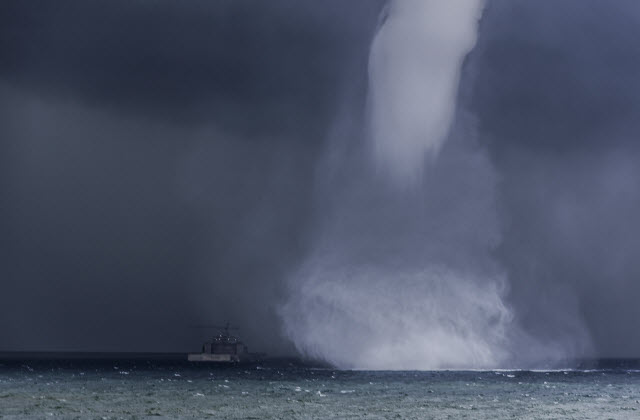
The Rare Phenomenon of Snowspouts
Snowspouts are rare events that mix snowstorms and waterspouts. These spouts form when cold air moves over warmer water. The cool air and warm water create an unstable environment for snowspouts to form. Snowspouts form like fair-weather waterspouts, but with cold temperatures instead of rain. The National Weather Service studies how these events occur.
Snowspouts often happen in areas where cold air masses travel across warmer bodies of water. The difference in air and water temperature causes an unstable environment perfect for snowspouts. Compared to regular waterspouts, snowspouts are harder to study since they rarely happen in remote places.
Although rare, observing snowspouts helps meteorologists learn about air and water interactions in cold climates. Studying snowspouts provides information on waterspout formations in different conditions. This knowledge expands our understanding of these natural phenomena.
While snowspouts pose little threat due to their remote locations and weaker structure, scientists remain interested in studying them. Researching snowspouts highlights the importance of fully comprehending waterspouts in all environments. These rare events showcase nature’s complexity and beauty.
What Are Waterspout Tornadoes and How Dangerous Are They?
While waterspouts can look exciting, their danger depends on the type. Tornadic waterspouts are like land tornadoes. They can cause a lot of damage, especially if they move onto land. Fair weather waterspouts are usually less severe. But they can still be risky for small boats, swimmers, and low-flying planes. The National Weather Service warns about them. How dangerous a waterspout is really depends on its type and if it affects people and structures.
See Also: What is Tornado Alley? USA’s Most Infamous Storm Corridor
Dealing With the Effects of Waterspout Tornadoes
Waterspout tornadoes can impact many things, like human activities and nature. For people on boats and living near the coast, understanding these effects is important for safety. Waterspouts can disrupt shipping, damage boats, and be risky for coastal buildings if they reach land. It’s hard to predict where they’ll go, which makes them challenging.
Early detection and warning systems help reduce waterspout risks. Coastal residents and boaters must pay attention to weather alerts and be ready to act if a waterspout is coming. Learning about signs of waterspout formation can also help communities prepare.
Waterspouts affect nature too, though not as much as humans. They can mix up water layers, impacting sea life. Their effects on wildlife are usually small, but understanding their role in nature is still valuable. Studying waterspout tornadoes and their place in the environment is helpful.
To deal with waterspout tornadoes, we need to take many steps. We need science work by groups like NOAA. We also need communities to be ready. And we need good communication. By learning all about waterspouts, societies can coexist with these natural events. We can stay safe while still seeing how amazing they are.
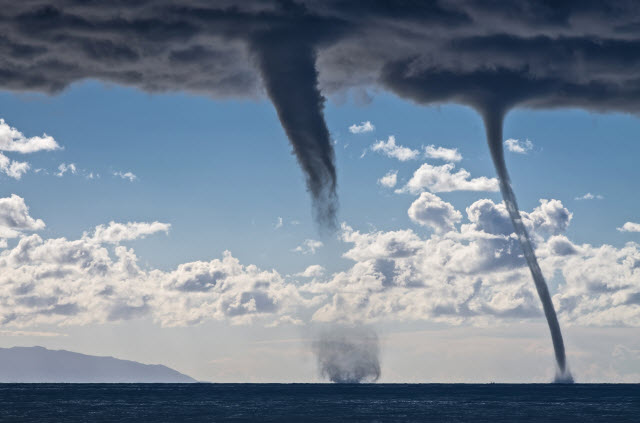
Waterspout tornadoes make it hard for ships and boats to sail. These twisters in the water are not as powerful. But they can form suddenly and mess up boating, fishing, and shore activities. People sailing in areas with many waterspouts must be alert, especially during peak times. Knowing the warning signs, like dark clouds forming and wind changing, is key to staying safe.
To stay safe from waterspouts, boats should change course and secure loose items. The items could get damaged or hurt someone in high winds. Officials will often warn ships about waterspouts nearby and tell them to find shelter. People on ships need plans for staying safe when a waterspout happens. Technology like radar and marine forecasts help predict waterspouts and warn people about them.
For people living near the shore, waterspouts can stop them from going to the beach. They put swimmers and surfers at risk. Local officials often make people leave the beach if a waterspout is nearby. Teaching people about waterspout dangers and why they should listen to warnings is important in these areas.
For sailors, fishermen, and people spending time near the ocean, learning safety rules helps keep them safe from waterspouts. By preparing and following guidelines, people can share the waters with these sudden whirlwinds without getting hurt, especially when waterspouts are rarely severe upon landfall.
Environmental Consequences: The Natural World’s Response
Waterspouts are cool to see, but they can affect the environment. When they form over water, they mix up different layers, changing marine ecosystems. This movement of nutrients can disrupt some sea creatures’ homes. But it can also bring nutrients from deep down to the surface, helping other species.
If a waterspout hits land, it can erode coastal areas and damage delicate places like mangrove forests and coral reefs. These ecosystems protect shorelines from erosion and provide homes for diverse sea life. A waterspout’s sudden wind and motion can destroy areas, taking years to recover, especially when they make landfall and affect regions not accustomed to such phenomena.
On a positive note, waterspouts help scientists learn about weather and marine life. Studying how they form and what they do gives insights into patterns and ecology. This research aids conservation efforts and helps find ways to reduce waterspouts’ negative impacts.
RehumanizeWaterspouts play a role in nature’s balance, acting as fair weather waterspouts or severe cases when making landfall. They are part of Earth’s ever-changing ecosystems, including as a type of waterspout that can impact the surface of the water. By studying and tracking waterspouts, we can better grasp their effects on the environment. Their presence shows we must respect nature’s power while safeguarding affected surroundings.
Clearing Up Waterspout Tornado Myths
Many myths and misunderstandings surround waterspouts. Their dramatic look and folklore tales add to the confusion. One myth claims waterspouts suck up water and fish from the ocean, then “rain” them down on land. While light objects can get lifted, “raining fish” rarely happens and is not directly caused by waterspouts.
Another myth is that waterspouts are always less dangerous than tornadoes on land. While most waterspouts are weaker, tornadic waterspouts that form over land and move to water can be just as powerful and destructive as tornadoes. Knowing the difference between tornadic and non-tornadic waterspouts helps assess their danger accurately.
Some think waterspouts only occur in tropical climates. However, waterspouts can form in various climates, including temperate areas, when conditions are right. This includes regions where cold air moves over warm water bodies, creating instability for waterspout development.
Lastly, some think that waterspouts are predictable and easy to avoid. While advancements in meteorology by the National Weather Service have improved forecasting, waterspouts can still form suddenly, making them unpredictable at times. Mariners and coastal residents must stay informed through weather updates and adhere to safety advisories to navigate these natural phenomena safely.
See Also: How Fast Do Tornadoes Spin? Wind Speed and Severe Weather
Separating Fact from Fiction in Waterspout Lore
There are so many fibs floating around about waterspouts. It’s gotten to the point where people can’t tell what’s true or false anymore. One of those misconceptions is that waterspouts are actually whirlpools or underwater tornadoes. The truth of it is, waterspouts form in the air above water like a genie coming out of his bottle, not under the surface. This myth probably started because some do have a swirling appearance to them – similar to a whirlpool sometimes monitored by the National Weather Service for its potential to transform into a waterspout.
Another one for you: Waterspouts are only recent occurrences, barely making their debut on the weather stage. Although tornadic waterspouts can blow onto land like their uncle the tornado, records show they’ve been around for centuries. They’re not some kind of Earthly reaction to climate change either but rather an occurrence that has captivated humans for as long as we could write.
Finally, some believe that once they make landfall, these watery terrors travel great distances and cause as much mayhem as they can muster up before dissolving back into dust. But most dissipate quickly after reaching shore because they lose access to their food source: warm water. Sure some do continue on land in whirlwind fashion but don’t worry your pretty little head about it – NOAA keeps tabs on these guys so any ill-fated souls can be sure to steer clear.
If there’s anything you get through your skull today — just remember this: Waterspouts often form together and share characteristics found in severe thunderstorms or cold air funnels. They’re never isolated events done in solitude either; always with friends and always linked with specific weather conditions which experts at NOAA watch closely… You know… For safety purposes!
Advancements in Waterspout Research and Forecasting
Innovation has taken the world of waterspout research by storm. And it’s all thanks to a mix of new technology, collaboration, public awareness, and education programs. By combining everything from radar tech, satellite imagery, and weather prediction models scientists have developed more efficient ways to detect conditions necessary for waterspouts to form. With light winds and flat bases beneath a line of cumulus clouds being detected more accurately than ever before.
Numerical weather model predictions combined with artificial intelligence and machine learning give meteorologists the ability to process data at much faster rates than humans can manage. This allows them to detect patterns that lead to a better understanding of how these unique water funnels move.
By sharing information worldwide meteorologists are not only educating the public but themselves as well. Comparing data between different regions allows scientists to refine their forecasting models and strategies effectively reducing the danger that waterspouts present on boaters and coastal communities.
Thanks again to more accurate forecasting authorities are able to broadcast warnings earlier. This gives people in potentially dangerous areas enough time to prepare themselves for the worst possible outcome while hoping for the best.
The ongoing efforts put forth by these professionals is promising news for everyone involved moving forward. Innovative technology continues to improve safety precautions while also minimizing potential damage caused by these natural phenomena.
Innovations Leading to Improved Prediction and Study
The way we research waterspouts has changed, and for the better. Now, meteorologists are able to use a mix of radar technology, satellite imagery, and numerical weather prediction models to create more accurate waterspout forecasts. When combined together, these tools allow scientists to learn what kind of atmospheric conditions are ripe for the development of a waterspout. Knowing things like light winds and flat bases beneath a line of cumulus clouds will increase the prediction’s reliability.
Additionally, artificial intelligence and machine learning can process data much faster than humans ever could. These technologies can go through enormous amounts of data in short periods of time while also finding patterns that would have been impossible for people to find on their own. This technology has recently been used by the National Weather Service in its forecasts to better predict when and where waterspouts develop.
As for marine warnings about waterspout sightings, they now have the ability to be more precise. Ships and coastal areas will receive timely alerts when there might be danger presented by waterspouts nearby them. By having this advanced warning system implemented into our current system we’re able to minimize navigation risks around coastal areas that might have some sort of waterspout brewing near them.
With all this in mind it should be mentioned how researchers are now making great strides towards better understanding intense waterspouts: Their life cycle and impacts, etc.. With this understanding they can develop strategies designed at mitigating their effects on human activities and marine environments.
Interesting Facts about Waterspout Tornadoes
Waterspouts, frequently seen tap dancing over the surface of the ocean, contain a lot of interesting information. For example, waterspouts are generally weaker than tornadoes which are land based ones and they pose less threat to buildings but still great danger for marine activities. The sight of a waterspout protruding from below an array of cumulus clouds is a breathtaking sight that exhibits the strength and beauty of nature.
Another fascinating thing about waterspouts is their capability to cause ‘animal rain’. This somewhat rare event transpires when tiny creatures such as fish or frogs are sucked up by a waterspout and then dumped on land areas. This bizarre occurrence has astounded mankind for ages and testifies to the capriciousness as well as strangeness of waterspouts.
Florida is the waterspout capital of the US
Florida is recognized as the Waterspout Capital of United States because its climatic conditions are exceptionally conducive to this kind of aquatic twisters which pull off water from oceans and then spins it upwards. The warm tropical climate and warm Gulf Mexico and Atlantic Ocean waters are good breeding grounds for many waterspouts that are often reported throughout the year, particularly in summer season.
The prevalence and visibility of these events make Florida a prime spot for waterspout research and observation, especially concerning waterspouts near the Great Lakes. Scientists, researchers, and fans from all over the world come here to learn more about how this phenomenon works and what causes it to happen. They bring with them data that can be used in ongoing attempts to understand and predict such spectacular natural phenomena.
The earliest waterspout in history
The recorded history of waterspouts dates back several centuries, with one of the earliest documented occurrences being a deadly waterspout that took place in the grand harbour of Valletta, Malta. This event, occurring in 1556, stands as a significant historical record, shedding light on the long-standing fascination and fear that waterspouts, especially those of significant size or when making landfall, have inspired in human societies. The Malta tornado, as it came to be known, caused considerable damage and loss of life, highlighting the potential dangers associated with these powerful natural phenomena, leading NOAA to examine the event closely.
This early account of a waterspout provides a glimpse into the challenges that people of the past faced when confronted with such unpredictable and destructive forces of nature. It also underscores the importance of advancements in the field of meteorology, which have since enabled better prediction, understanding, and management of waterspout risks, safeguarding lives and properties against their potential impacts.
Waterspouts can cause animal rain
The phenomenon of animal rain is one of the most whimsical and bewildering aspects associated with waterspouts. When these spinning columns of air pass over water bodies, they can pick up lightweight creatures such as fish or frogs and carry them over distances. Once the waterspout loses its energy and dissipates, the animals are released from the grasp of the vortex, falling like rain from the sky. This rare occurrence has been documented in various parts of the world, including the Great Lakes, leaving witnesses in awe and sometimes disbelief.
Although animal rain might sound like a myth, it is a scientifically explained event directly linked to the mechanics of waterspouts. This bizarre yet fascinating natural spectacle serves as a reminder of the many wonders and mysteries of the natural world, many of which continue to puzzle and fascinate scientists and laypeople alike. Waterspouts, with their unique ability to interact with the environment in unexpected ways, remain a subject of ongoing research and curiosity.
The Final Swirl: Reflecting on the Power and Beauty of Waterspout Tornadoes
Waterspout tornadoes are amazing. They are powerful and beautiful. They show the connection between oceans and air. When they form, nature is on display. From the spray ring when the funnel appears, to the spinning motion that draws our eyes. This is seen in places like South Florida, where warm seasons create great conditions for waterspouts.
The National Oceanic and Atmospheric Administration (NOAA) watches any waterspouts that may move over land. These twisters are like tornadoes on land. Both need wind speeds and spin at their core. But waterspouts often stop quickly on land, losing energy from coastal waters. That’s why they don’t rate highly on the Fujita scale, which measures tornado intensity. But they are still dangerous if you are sailing through them. Watching one form is like magic unfolding. It starts with a pale disk at sea — something happening between the cloud and water.
This happens worldwide in bodies of water, from Lake Michigan to tropical cyclone areas. No matter how they form, each tells a story about the atmosphere or location. Though dangerous, waterspouts are part of nature’s art — a reason people vacation at shores again and again. Seeing a waterspout thrive then fade is evidence of nature’s delicate balance, captivating those who spot one forming. Studying these storms has brought milestones in predicting when they form and how they behave. It’s important to admire their beauty from a safe distance.
That’s why efforts continue to learn more about them. As knowledge grows, it helps create safer boating conditions while teaching about what’s beneath. In summary, waterspout tornadoes show nature’s amazing ability to work magic. We must appreciate them from afar and respect their power– never get too close for a selfie when one nears. Enjoying natural phenomena like this teaches that there is balance between admiration and caution. And as we watch the final swirl in its last breaths, our world becomes even more enchanting.

